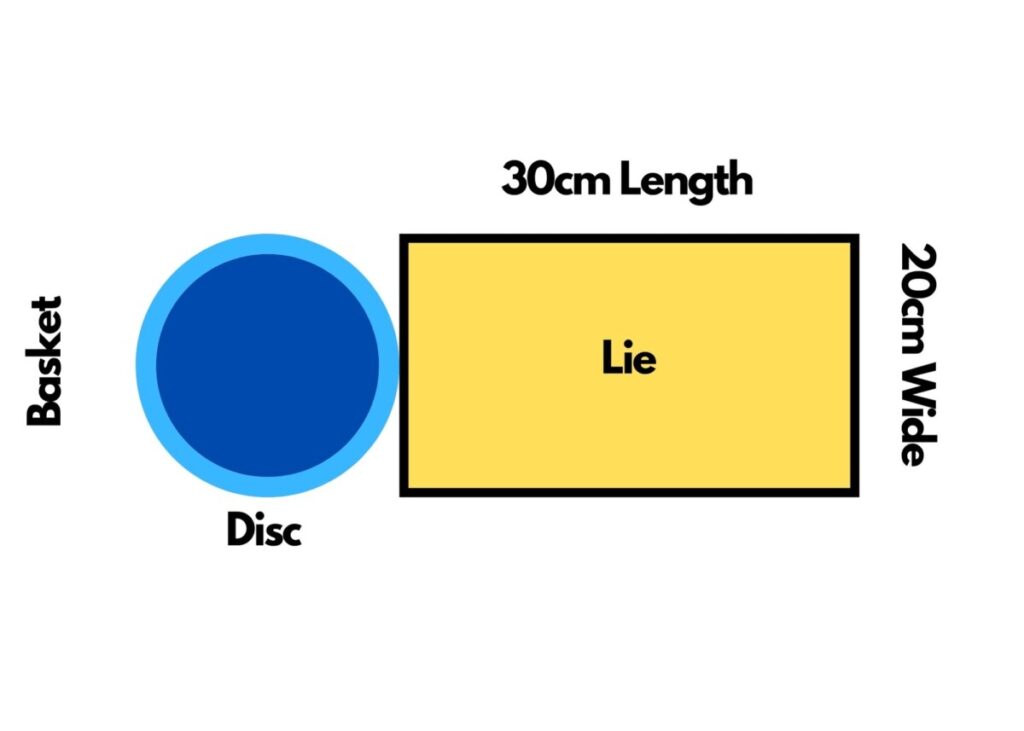Jumping in disc golf would be helpful in certain situations to generate some extra momentum behind difficult shots.
There is a fine line between a successful jump putt and a foot fault. In this post, we’ll cover the rules of a jump putt and how to pull it off successfully.
Table of Contents
Here’s When You Can Jump in Disc Golf
You can jump in disc golf when throwing, and it makes the most sense to jump when putting from longer distances. This is called a jump putt. The jump putt is useful because it allows a player to use their leg power and momentum to add distance to a putt while maintaining control and without foot faulting.
In this post, I’ll explore what a jump putt is and how you can implement it into your game.

What is a Jump Putt?
A jump putt is when you use the power generated from your legs and the momentum from your weight as you jump to add distance to a long-distance putt.
You might be wondering why you need to jump at all to gain some extra distance? Putting doesn’t have the same rules as the tee box for throwing the disc. When throwing from the tee area, you’re allowed to get a head start before throwing the disc.
The rules for a foot fault or a stance violation are different when putting or throwing from the fairway. Your lie is a much smaller area to throw from, so there is no way to get any kind of run-up into the shot for extra distance.
This is why a jump putt is an effective way to get that small amount of extra distance and power behind a long putt.
Can You Foot Fault on a Jump Putt?
A foot fault or the official term of a stance violation used by the PDGA states that a player must have at least one supporting point in contact with their lie when throwing the disc.
What this means for a jump putt, is that even though you’re jumping to generate extra distance on the throw, when you release the disc you need to still have at least one supporting point within the lie.
Remember that the lie is a 30cm x 20cm rectangle. If you move your feet in front of the lie before releasing or releasing the disc without a supporting point within the lie, this will be a stance violation.

Some of these rules for foot faults or stance violations can be weird and confusing. If you’re still confused about the difference stance violations or foot fault rules, I’ve written a complete guide that should clear the fog.
When to Use a Jump Putt
There are certain situations that you might find yourself in from time to time that will require a jump putt. But, I’ll preface this by saying jump putts aren’t necessarily an easy shot.
Jump putts take time and practice to perfect before you’re going to confidently use them in a round that might matter.
Here are a few times when you’ll want to consider using a jump putt if you’ve added one to your game.
1. Just Out of Normal Putting Range
If you find yourself close enough to the basket that you need the control of the putter, but far enough away that you’re just out of normal putting range, the jump putt might be a good play.
Jump putting will provide your putt with a little more power that’s needed to get a putt to the basket when you’re in the gray zone on the course.
You should know what your max range is for putting before deciding if you’re at a distance from the basket where a jump putt makes sense.
2. No Drop-Offs Behind the Basket or OB Nearby
A jump putt is going to provide extra power and distance on a normal putt, but with that comes some risk. If the disc happens to hit metal on the basket or miss completely, you could end up much further away from the basket.
A jump putt is made even riskier if there is an out-of-bounds close to the basket. A jump putt can be a gamble especially if the chances are high that if you miss your disc lands in the OB area.
Similarly, a drop-off directly behind or to the sides of the basket could leave your disc sailing down a hill or rolling down the hill.
3. There is an Obstacle
At times there are obstacles like a small tree or bush that you won’t be able to throw around. If the disc needs to clear the obstacle and still land flat, the jump putt could be the best option.
Throwing a jump putt could put the disc over the obstacle and still allow it to land softly in front of the basket or even in the basket.
4. Uphill Approach to the Basket
A steep uphill approach to the basket can be a difficult shot for sinking a putt in the chains of the basket.
A jump putt can give your throw an extra push up the hill to get to the basket, or lay-up close enough for a very makeable putt at the top of the hill.
Rules to Know For Jump Putts
There are several rules to know when attempting jump putt. These rules will pertain to what is and isn’t a stance violation for a jump putt and where you can use it on the course.
Be Outside of Circle 1
Circle 1 is a circle around the basket that extends 10 meters or 33 feet from the basket in all directions. A jump putt inside of this circle is illegal.
When you’re within this 10-meter boundary, no supporting point can touch in front of the lie until the player has “full control of balance”.
This can be a little bit of a gray area when it comes to determining what is or isn’t a foot fault.
Full control of balance is an important difference because throwing from the tee or the fairway, a player can step over the front of the lie after the disc has been released, regardless of whether they’ve established balance or not.
Follow the Fairway Foot Fault Rules
Outside of the 10 meters around the basket, it’s not illegal to step in front of the lie, but you still will have to have one supporting point within the lie at the time of the release.
The back edge of the disc is where the front edge of the lie begins. The lie uses an imaginary rectangle that measures 11.8″ x 7.8″ (or 30cm x 20cm).
It’s much easier to imagine a piece of 11″ x 8″ printing paper, centered behind the back edge of the disc.
Release With One Supporting Point in Contact With the Lie
The trickiest part of pulling off a jump putt is the fact that when the disc leaves your hand, you’ll still have to have at least one supporting point touching inside of the lie.
This means that you can’t throw the disc when both feet are in the air from jumping.
On the other hand, when the disc is released from your hand, no supporting point can be in front of the lie either.
How To Jump Putt the Right Way
Jump putting requires practice and good form to not only stay within the rules for a stance violation but to also release a putt that is powerful but controlled enough to reach the target.
Below are the seven steps to a successful jump putt in disc golf.
1. Use Your Legs for Power
As with any putt, the power to throw the disc will need to come primarily from your legs. This is no different for a jump putt and even more so.
Because of the rules when throwing from the lie, you will need to use your legs, rather than your arms to generate the force behind the disc when thrown.
Remember, that one supporting point should be within the lie when the disc is thrown.
2. Widen Your Stance
Since you’re going to be jumping you’ll want to widen your stance a little more than you normally would when putting.
A wider stance will keep your weight balanced when you jump and add more control to the disc when thrown.
3. Release on Time
As I discussed earlier, the time of release is crucial to avoid the one-throw penalty for a stance violation.
When the disc leaves your hand, you should still have one foot touching inside of the lie. If your throw happens with both feet in the air you’re going to get hit with a foot fault.
4. Use Your Momentum to Guide the Disc
A jump putt is effective because the momentum from jumping is transferring through your legs and to the disc when thrown.
The key here is to use that momentum to help guide the disc in a controlled manner. Otherwise, your throw is going to be wild and inaccurate.
Use your momentum to guide the throw toward the target.
5. Maintain Control
Maintaining control of the disc starts with using your momentum to guide the throw to the basket, but there is a second factor to maintain control too.
If your throw doesn’t have the right amount of spin to match the momentum generated through the legs, the disc will wobble in the air.
It takes some practice to match the spin with the speed that the disc is thrown.
6. Start the Throw From the Knee
One way to create enough spin on the disc to match the speed is to start your throw from near the knee.
This longer throwing motion helps to give the disc enough spin when thrown to eliminate any wobbling.
Start from the knee area and come up with the disc as you enter into the jumping motion, releasing the disc right before your front foot leaves the ground.
7. Follow-Through
In other sports like tennis, ball golf, or baseball players hit the ball, but when they hit the ball they don’t stop their swing.
The follow-through is important for a jump putt because it will allow you to keep your balance and create a controlled and accurate shot.
The jump putt follow-through also helps to guide the momentum of the throw explained in step 4.
Summary | Can You Jump in Disc Golf
Jumping in disc golf should be used strategically in certain situations to give an extra edge to make a shot.
A jump putt in particular is the most common way that jumping can be used to create distance on a putt or avoid an obstacle.
The jump putt does take some practice to properly execute and control. So, start close and work your way further out to perfect your jump putt.
